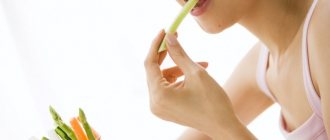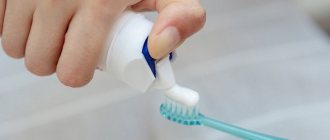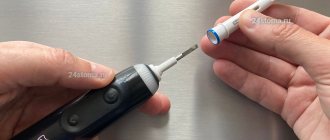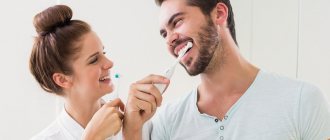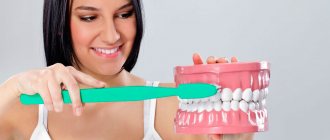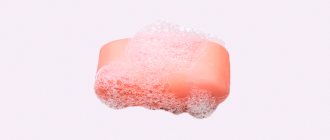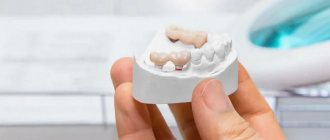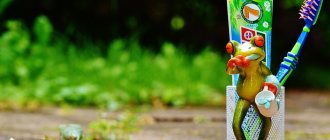Ksenia Kotova editor of Dental Magazine
From time immemorial, humanity has been concerned about oral hygiene. Studying the remains of teeth that are 1.8 million years old, archaeologists have determined that the small dimple-shaped depressions on them are the result of the impact of a primitive toothbrush. Originally it was just a tuft of grass that people used to rub their teeth to get rid of stuck food fibers. Over time, a tool for cleaning teeth has become not only a hygiene item, but also an indicator of the status of the owner. For example, in Japan, China and Ancient India it was made from precious metals.
It is known that in ancient times people used salt, chalk or soot and rubbed them into their teeth using their fingers or a piece of cloth.
Already in 3500 BC. e. the inhabitants of Babylon, Greece and Rome made special chewing sticks from fragrant branches of the mastic tree. The twig was chewed from one end, leaving a pointed edge and using it as a toothpick.
Rice. 1. Chewable licorice root stick.
In ancient India, teeth were cleaned with a mixture of charcoal, gypsum, resin and roots of medicinal plants. In India, chewing twigs made from the branches of the neem tree are still sold.
Rice. 2. A stick for cleaning teeth made from neem tree branches.
The Egyptians, and especially noble nobles, whitened their teeth enamel with powder made from raisins, myrrh and frankincense. Crushed ram's horn was used as an abrasive.
The toothbrush has come a long way since its inception, and the history of its development is fascinating and amazing!
Researchers believe that dental instruments similar to those used around the world today were invented in China in 1498. Its bristles were stiff and consisted of coarse hairs taken from the back of the pig's neck. The handles to which the bristles were attached were made of bones or bamboo.
Rice. 3. China is considered the birthplace of the toothbrush.
In Russia in the 16th century, similar “tooth whisks” were also known, consisting of a wooden stick and a brush made of pork bristles. These inventions were delivered to Russia from Europe.
Rice. 4. The “toothbrush” accompanied every self-respecting boyar at royal feasts.
Under Peter I, the royal decree ordered that the toothbrush be replaced with a cloth and a pinch of crushed chalk. In the villages they continued to rub their teeth with birch charcoal, which whitened the teeth.
Why do you need to brush your teeth?
Prevention of dental diseases and care include daily brushing of teeth with a brush and toothpaste 2 times a day. If you do this rarely, plaque builds up. And when care is performed more often, there is a chance of damage to the enamel.
If regular cleaning is not done, then a problem appears in the form of bad breath, plaque and yellowish discoloration, and dental ailments. Dentists advise brushing your teeth before breakfast, not after. The reason is the presence of a biofilm of plaque and bacteria that remains on the teeth after an overnight rest.
Bristle hardness level
The main cleaning element of any toothbrush is the bristles, the action of which allows you to remove food debris, plaque and harmful bacteria from the surface of the teeth, tongue and gums. Taking this factor into account, there are the following groups of toothbrushes:
- Brushes with soft bristles are most often intended for use by young children, patients after surgery, for teeth with damaged enamel, a tendency to wear off the enamel, and wedge-shaped pathologies.
- Hygiene items with medium-hard bristles are standard toothbrushes that provide optimal cleaning and are suitable for regular use for people with healthy teeth.
- Stiff toothbrushes are useful when cleaning dentures or orthodontic appliances.
Siwak tree sticks
This is another answer to the question of how to brush your teeth if you don’t have a toothbrush. Siwak tree sticks are sold online in vacuum packaging, which includes several pieces. In ancient times they were used for cleaning. One stick can be used for a month.
You just need to follow the general storage rules: keep the box of sticks open to prevent mold and store in a non-humid place. How to brush your teeth without a toothbrush using this device? The procedure is simple: you just need to chew it, having cleared the bark in advance. In “field conditions” you can find a 15-20 cm stick, remove the top skin, after which it is ready for use instead of a brush.
Number of rows and nature of bristle arrangement
The functionality and hygienic properties of toothbrushes are ensured by the specific arrangement of the bristles. Accordingly, there are the following groups of hygiene instruments:
- One block of bristles is typical for brushes that are used in the presence of orthodontic or orthopedic structures.
- Two rows of fibers form a hollow groove between themselves. This design is suitable as a hygienic means when using a braces system.
- Three rows of bristles – a brush with bristles arranged in three longitudinal rows provides gentle cleansing and prevents damage to gums and soft tissue.
- Four rows of fibers is the most common bristle pattern. This model of toothbrush is optimal and is often recommended by dentists for patients with healthy teeth.
Finger
How can you brush your teeth if you don’t have a brush? If there is nothing, you can use your own finger. First you need to wash your hands. The index finger is used to brush, making circular movements over the teeth and gums. If there is a paste, it is first applied to the finger. You should thoroughly rinse your finger when moving from the lower to the upper teeth.
Why do you need dental floss?
Dental floss, or floss, is a mechanical device made of nylon or other material that allows you to remove food debris from the interdental spaces. In addition, it helps remove plaque from teeth from hard-to-reach places. This remedy has been used since the 19th century. Without dental floss, oral hygiene is considered incomplete, since the brush cleans only ⅗ of the tooth surface. Bacteria remaining in the mouth lead to the development of caries and other pathologies.
Today there is a huge number of dental flosses that differ in material, impregnation, length, thickness, etc. (Biorepair Biorepair® Filo Non Cerato Ultrapiatto, Miradent Mirafloss chx-Tape, Coswell SPA Biorepair® Filo Cerato Espandibile). Some flosses not only clean your teeth, but also freshen your breath. Regardless of the specific variety, threads have the following advantages:
- reduce the risk of dental caries;
- have a deodorizing effect;
- cleans well of solid deposits;
- prevent darkening of the enamel.
Dental floss as a means of hygiene also has disadvantages:
- there is a risk of soft tissue damage;
- inability to clean with small gaps between teeth;
- duration of the procedure.
It is advisable to use it every time after eating. Now let's try to determine whether it is possible to replace dental floss with an irrigator.
Irrigator
This is a special device that helps remove plaque and food debris using water or medicine. According to dentists, using an irrigator instead of floss and brush is much more effective for the entire oral cavity.
The irrigator (aerator) includes a compressor or hydraulic pump, a water container, a set of different nozzles and a comfortable handle. Water or medicinal liquid is supplied into the mouth by a compressor through a nozzle under pressure. This cleaning removes food debris and plaque, improves blood circulation in the gums, and makes them stronger.
The attachments include classic, periodontal, orthodontic, nasal, with a mini-turbine or a spoon for cleaning the tongue. Irrigators can be used for prevention or therapy if a special solution can be used instead of water. There are devices where water is supplied by pulsation or air microbubbles. The device can be used in any environment, it is only important that there is a charged battery or power supply.
How an electric toothbrush works
The design of an electric toothbrush is simple. The main place in the thick handle of the device is occupied by the battery. There is a simple inverter that converts direct current into high-frequency oscillations, and bristles. The batteries are charged via a special adapter. They produce docking stations where the bristles receive a share of ultraviolet light for disinfection. Relevant when brushing without toothpaste. A humid, warm environment provides excellent conditions for the growth of bacteria, which can lead to big problems.
The bristles vibrate at high speed to help the bristles effectively remove plaque. The frequency is thousands of vibrations per minute. In electric ultrasonic toothbrushes, the frequency exceeds the threshold audible to the ear, approaching 20 kHz (1.2 million movements per minute - the ideal speed for affecting plaque). Tartars fall off instantly. The downside is that old fillings fall out. The instructions provide more details about contraindications.
Moving at this speed, the bristles remove plaque more effectively. Standard electric models are inferior to ultrasonic ones. Equivalent frequency oscillations are used in medicine. Penetrating deep into the gums and bone tissue, the waves have a disinfecting effect, promoting regeneration and increasing immunity. An electric toothbrush cannot be considered therapeutic, but beneficial effects are observed.
Useful tips
There are recommendations that allow you to brush your teeth efficiently:
- You should not start cleaning earlier than 15 minutes after eating. This increases the effectiveness of the paste. After eating some food, for example, spicy or sour, the procedure should be performed no earlier than half an hour later.
- It is advisable to brush your teeth after breakfast and before going to bed at night. Dentists consider this time to be the most suitable for these procedures. Brushing before bed prevents the growth of harmful microorganisms in the mouth, since the salivary glands function weakly at night.
- Cleaning should be done for at least 3 minutes, but do not overdo it. Cleaning for too long (more than 10 minutes) can lead to problems with the enamel, especially when using a paste with a high fluoride content.
- During the day, you need to use toothpicks to remove food particles in the interdental space. The procedure must be performed carefully to prevent injury to the gums and infection in the wound.
- You should independently identify problem areas and give them due attention. For effective care, it is advisable to consult a dentist.
- You should pay attention to the gums, since often beneficial effects for the teeth lead to damage to other areas of the cavity. Bleeding gums can be a symptom of gingivitis.
- Using mouthwashes is not necessary, but it provides a comprehensive approach to prevention.
How to use an electric toothbrush
The paste is whipped on bristles into foam. High frequency shaking turns the jelly-like substance into milk. There is no need to rub the composition on tooth enamel. The whipping happens instantly, so you shouldn’t put too much toothpaste: it will flow onto the floor or into the sink.
Ultrasound, penetrating deep into the gums, improves blood circulation and has other beneficial effects for improving the health of the oral cavity. Use attachments according to instructions.
Do not repair your electric toothbrush yourself. Deviations from the norm can adversely affect the overall health of the oral cavity. It is fraught with expenses for dentists that exceed the cost of devices, loss of time and nerves. A filling costs from 4,000 rubles, an implant is 10 times more expensive.
What to replace pasta with?
There are situations where there is not only a lack of a brush, but also a lack of toothpaste. What to do in this case? You can find an alternative to pasta at home. The following tools can be used instead:
- Tea tree oil. It is rubbed into the enamel. The product has an excellent whitening effect that occurs naturally. Moreover, the oil does not have a negative effect or destruction properties. It also strengthens enamel, protects against inflammation and disinfects the oral cavity. But you need to take into account the minus of the oil - the presence of a pungent odor and bitter taste.
- Salt. The product is effective for cleaning teeth, as it has an antiseptic, anti-inflammatory and regenerating effect. Salt easily gets rid of bad breath. It is very easy to use: dip the brush in water, apply salt to it, and clean it without sudden movements or strong pressure.
- Baking soda. The product perfectly cleanses enamel, but it should only be used in rare cases, otherwise it damages the teeth. It is advisable to perform such procedures no more than once a week.
- Powdered milk. The product is also ideal for those who have bleeding gums or tartar. It copes well with unpleasant odors, but the effect is not long lasting. Powdered milk should be used as a powder.
- Clay powder. Your teeth will be noticeably whiter after using it. White clay needs to be dried and ground into powder. Then a couple of drops of ether are added. There is ready-made powder in stores.
- Activated carbon. With it, teeth become whiter, pigment spots are also eliminated, the microflora of the oral cavity is normalized and toxins are eliminated. Charcoal gets rid of bad breath. But you shouldn’t use it constantly, because it injures the enamel.
- Hydrogen peroxide. The solution is considered an analogue of professional cleaning. It is not advisable to use it more than once a week. Hydrogen peroxide gets rid of yellowness, eliminates unpleasant odors, and also provides an antiseptic effect.
Therefore, there is nothing to worry about if you don’t have a toothbrush. It can always be replaced with improvised means. Just don’t overuse them, because these methods are only suitable for extreme cases, and full cleaning is still necessary.
Characteristics of bristles
Natural or artificial bristles - what to choose?
Currently, the production of natural bristle bristles is kept to a minimum for several reasons:
- The rigidity is usually high.
- The tip of the bristles cannot be rounded (cannot be processed), it is traumatic for the mucous membrane, and easily flakes.
- There is a small cavity inside the natural bristles, due to which they absorb moisture and promote the proliferation of harmful microorganisms in the oral cavity.
- Surface with burrs, porous.
- Devices made from natural materials quickly become unusable due to fragility and abrasion of the bristles.
Toothbrush bristles were traditionally made from hog bristles. Natural bristles, due to certain disadvantages, limited and reduced the possibilities for developing more advanced toothbrushes. Currently, technology has been developed for rounding, grinding and polishing the tips of each artificial bristle. Due to the undeniable advantage of artificial fiber for the manufacture of toothbrushes, the production of brushes with natural bristles is kept to a minimum.
The ideal choice would be a tool made of synthetic fibers (usually nylon).
Bristle hardness
The bristles of toothbrushes can be of different thickness (which largely determines their rigidity), mobility, and with differently processed tips. The optimal bristle height is 10-12mm.
The most important parameter for classifying toothbrushes is the stiffness of the bristles. However, this indicator is not standardized and there is no single criterion for the stiffness of the bristles. Some manufacturers distinguish 5 degrees of hardness:
- Very tough
- tough,
- medium hardness (nylon bristles with fiber diameter up to 0.22 mm),
- soft (nylon bristles with fiber diameter up to 0.2 mm),
- very soft (nylon bristles with a fiber diameter of 0.15 - 0.18 mm).
Manufacturers sometimes use fibers of different diameters in brushes, but at the same time indicate the same degree of hardness.
Soft brushes are intended for cleaning temporary teeth, teeth with weakly mineralized enamel, as well as for inflammatory diseases of the periodontium and oral mucosa in order to avoid injury. Hard bristles should be used when the enamel is mature and there is a tendency to increased formation of mineralized and non-mineralized dental plaque.
Many modern brushes combine bristles of different hardness:
- central, stiffer bristles are designed to effectively clean the chewing surfaces of teeth (they are often shorter),
- peripheral softer (usually longer) bristles are less traumatic, clean the gingival groove, penetrating quite deeply into it (Junior Blend-a-dent, Medic Blend-a-dent, Colgate Plus brushes).
You can often see that bristles of different degrees of hardness are marked with different colors.
Artificial bristle tips
In modern toothbrushes they are rounded, which increases their polishing ability and prevents injury to periodontal tissue and the oral mucosa. The tips of the bristles can be:
- Rounded ones scratch the gum least of all;
- Pointed ones - better clean teeth and the spaces between them;
- Blunt - massages the gums well.
Cleaning heads
Toothbrushes are made with cleaning heads of different sizes and shapes. Products with rounded and rounded corners are considered less traumatic for the mucous membrane.
The cleanliness of the tooth surface depends on the width of the head. Its length is usually no more than 30 mm. The small size allows the brush not to injure the teeth or mucous membranes of the opposite side of the mouth during cleaning.
The area of the brush head affects the number of tufts of bristles located on it:
- instruments for adults have from 47 to 55 tufts;
- There are 23 tufts on children's brushes;
- devices for teenagers are produced with 39 beams.
Mono-beam products are also worth mentioning. With just one beam, they help maintain the cleanliness of the oral cavity with orthodontic systems and irregularities in the dentition.
Micro-textured bristles for toothbrushes
The ORAL-B company has developed microtextured bristles for toothbrushes . New patented technology increases the texture of each bristle by applying a polymer coating to each nylon bristle.
These bristles are designed to more effectively clean the surface of teeth not only with the tips of the brush, but also with their side surfaces. The microtexture is located throughout the surface of the brush, but it is so small that it can only be discerned using an electron scanning or atomic microscope. Its size and shape matches the microtexture of the surface layers of enamel, which further increases the cleaning effectiveness of the toothbrush.
Brushes with silicone lugs
New developments include brushes with silicone ridges instead of nylon bristles, and with a soft synthetic elastomer plate built into the head to scrape away plaque and the surface of the tooth (Signal).
With use, the bristles of the toothbrush wear out - the bristles fall out, become loose, lose shape, bushiness, and shorten the bristles. Such changes make the brush unsuitable for further use and require its replacement. The brush should be replaced at least once every three months, although many authors recommend even more frequent replacement. However, the rate of wear of a brush can vary significantly depending on the force of pressure on it, frequency of use, toothpastes and powders used, and individual characteristics of the structure of the dentition. For example, it has been determined that for effective cleaning, the pressure on the toothbrush should be 60-80g; Some hygienists recommend that their clients test this pressure by applying pressure to a postal scale with a brush.
Use of CUREN® polyester fibers in CURAPROX brushes
If the bristles of the brush are soft, then it will not cause any harm. If, in addition, the bristles are thin, then the grooves of the teeth are easily accessible, and such a brush carefully eliminates harmful bacteria. This is important, since especially many bacteria accumulate in inaccessible places that can be easily damaged.
The CURAPROX CS 5460 ultra soft toothbrush meets all these criteria. The bristles of such a brush, or bristles, as they are also called, are so thin that it easily penetrates into the grooves, which are serious spaces between the teeth and gums, and cleans gently without causing damage. CURAPROX toothbrushes use CUREN® polyester fibers. CUREN ® fibers absorb significantly less moisture than nylon, which is used as bristles in various other standard toothbrushes. CUREN ® fibers remain strong even when wet, the bristles of the toothbrush do not deform and retain their shape for a long time.
Dense bristles that gently clean the tooth surface.
These 5,460 bristles, with an unusually high number of fibers, are tightly packed onto the compact head of the toothbrush. This guarantees a high level of efficiency: each movement of the CURAPROX CS 5460 ultra soft brush when brushing your teeth removes much more plaque than hard toothbrushes with widely spaced bristles and harmful plastic inserts that create the illusion of volume.
If this is accompanied by the correct brushing technique, then everything is done correctly and usefully for excellent oral health!
Fiber bundle arrangement
In the brush head, the bristles are organized into tufts, which are usually arranged in 3 or 4 rows. This arrangement allows for better cleaning of all surfaces of the teeth.
As a rule, the tufts of bristles have different heights: longer (softer) along the periphery, shorter ones in the center.
Each group of beams contributes to a more thorough removal of plaque in a particular area of the dentition. Straight tall fibers clean plaque in the interdental spaces, and short fibers clean plaque in fissures. Bundles of fibers located in an oblique direction, penetrating into the periodontal sulcus, remove plaque from the cervical area.
Toothbrushes with V-shaped fiber bundles are recommended for cleaning plaque from the contact surfaces of teeth in those who have wide interdental spaces.
Some toothbrush models have a power projection for better cleaning of the molar, especially the distal surfaces of the last molar and deep penetration into the interdental spaces.
Often toothbrushes have an indicator - two rows of tufts of fibers colored with different colored food dyes that fade with use. The signal to replace the brush is when the bristles become discolored by half their height. This usually occurs after 2-3 months with brushing your teeth twice daily.
